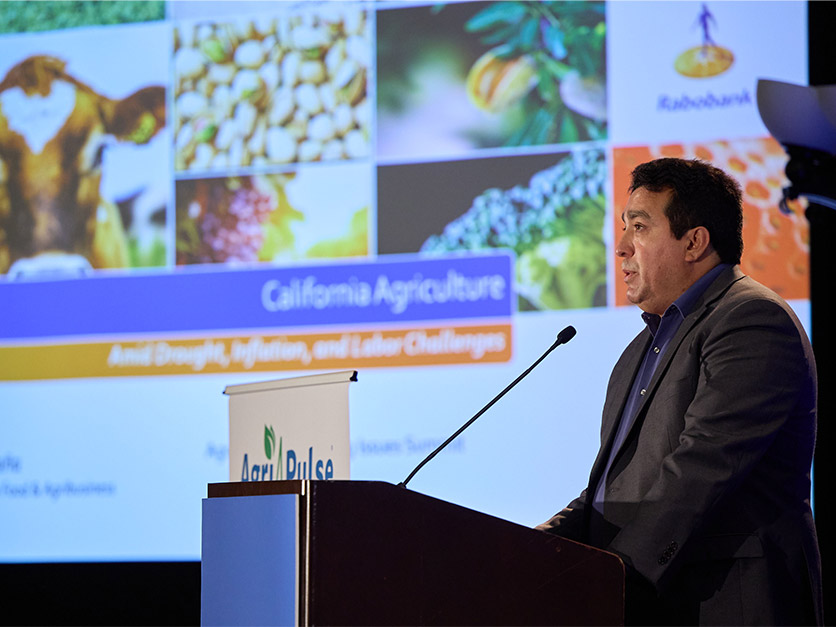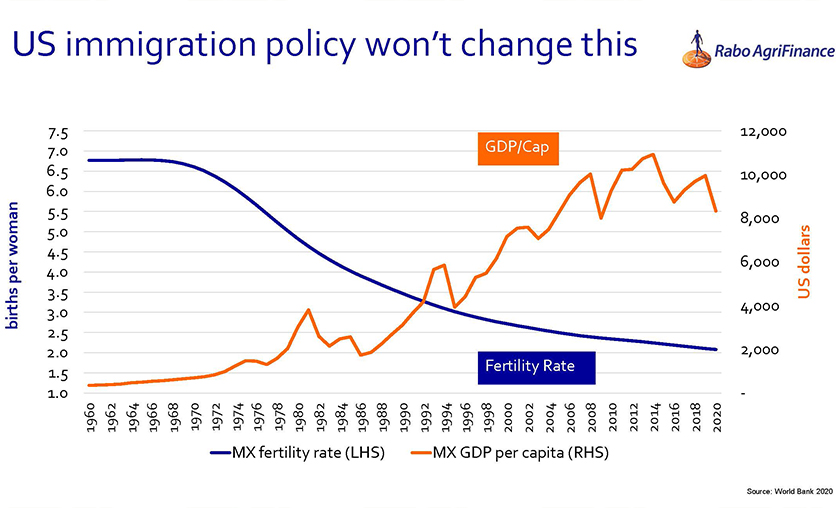If there was just one challenge facing those involved in California food and agriculture, the outlook might be a bit more positive. But when you consider the third year of drought, the need to feed a growing global population, supply chain disruptions, labor shortages, the COVID-19 pandemic, regulatory constraints, inflationary pressures and geopolitics, “we’re right in the middle of a perfect storm,” says David Magaña, senior analyst, RaboResearch Food & Agribusiness.
Speaking at the Agri-Pulse Food & Ag Summit last week, he argued that the combination of factors that came together within the last two years “should be considered a Black Swan event” that was unpredictable yet can have severe impacts. In addition, “We have this massive collision between demand side pressure and supply side constraints” that will continue to pose challenges, he added.
All of these factors will likely bring changes, but that’s nothing new for California agriculture, Magaña said, while noting that he’s optimistic about new innovations solving agriculture’s toughest issues.
“If you look back at the main challenges for California agriculture 100 years ago, it was access to water, labor, and transportation. Today, the same challenges exist, plus many others. Different names and different magnitudes.”
Adding to the complexity: Consumers who may have contradictory desires. For example, he said consumers want year-round fresh food. But at the same time they want it to be local.
They want more convenience, but less plastics. They want food to be affordable, even in the presence of many supply side challenges, he explained.
 David Magaña, senior analyst, RaboResearch Food & Agribusiness, presenting at the 2022 Agri-Pulse Food & Ag Issues Summit.
David Magaña, senior analyst, RaboResearch Food & Agribusiness, presenting at the 2022 Agri-Pulse Food & Ag Issues Summit.
It’s no secret that drought is impacting planted acreage, yields, crop mix and the cost of water, but 2022 is different than the previous drought from 2014 that ended just before 2017, Magaña said. One of the main differences this year is that the Sustainable Groundwater Management Act is now in place, input costs are more expensive and prices for almonds and other crops, are lower. He suggested that over one million acres of California farmland could be fallowed “sooner than later.”
“The University of California was estimating that because of SGMA, over the next 2-3 decades, about 1 million acres would need to be fallowed. The same university in a different study, estimated that as of 2021, 400,000 acres were already fallowed.”
“In general, farmers will continue to allocate water to the highest economic use. When you look at gross returns for almonds, pistachios and walnuts, this industry been favored compared to stone fruits and others because of water availability and labor challenges. By 2026, he said the bearing acreage for walnuts is projected to be twice that of 2000, almonds three times and pistachios almost seven times larger.
Keep in mind: Almonds will continue to be the economically significant industry in the tree nut space, he added.
Don’t miss a beat! It’s easy to sign up for a FREE month of Agri-Pulse news! For the latest on what’s happening in Washington, D.C. and around the country in agriculture, just click here.
On the vegetable side, he said to expect more kale, cauliflower and brussels sprouts to be planted in California’s future.
At the same time, we will see more competition for U.S. crops like blueberries, avocados and table grapes coming from Peru. Magaña described the country as a new “powerhouse in terms of fruit exports” after they diverted water that had been naturally flowing into the Amazon into fruit production.
One challenge that Magaña said is not going to be solved anytime soon is the labor situation.

“A decade ago, we saw single adults coming across the border to work temporarily and go back. Now it’s more family units and companion children coming across,” he said. “The people who were crossing were from central or west central Mexico but those numbers have declined sharply. So you will not have people with experience working in agriculture coming across.
“Workers still in Mexico now have more ag jobs available at home. A lot of these labor intensive crops are increasingly being grown in Mexico and exported to the U.S. market, particularly berries, avocados and all of those vegetables.”
Plus, nothing we can do to U.S. immigration policy will change fertility rate, Magaña said. “Family size in Mexico has changed from about 7 children to 2. The cohort of people from ages 15 to 45 is going to be declining. The next generation is more educated and not interested in working in agricultural fields. They may be able to help develop new innovations.”
For more news, go to: www.Agri-Pulse.com


